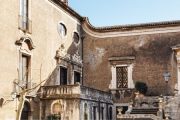On our trip to the impressive Amber Fort, built high up on a bare hillside outside Jaipur some 400 years ago by Muslim Moghul invaders, we had to abandon the bus and take a jeep ride through narrow streets of grinding poverty and smells of ordure, passing an untethered warthog making threatening gestures at a wildly barking mongrel dog, to arrive at an overcrowded staging area thronged with hawkers, beggars, and bewildered tourists seeking entrance to the fort, which offered spectacular views of the crumbling old town in the valley below, beyond a dried-up lake bed. From a latticed screen above an entryway, privileged Muslim ladies in purdah could look down on visitors, but the building itself, bare of ornament and stripped of furniture, is but a shadow of its former glory, now a mere monument to departed invaders.
Back past the abandoned Water Palace, our Muslim guide took us to an open-air observatory, a jewellery workshop, and to the City Palace Museum in Jaipur, now a sanctuary for artisans and craftsmen, with monkeys running along the top of its high encircling walls. We saw a hubbub of busy textile and carpet workshops, and my wife and sister-in-law went on the prowl for tablecloths and cotton dresses. Mr. Karamveer negotiated crowds, narrow lanes, and traffic jams at all of these places with commendable skill and patience. If you were stopped in traffic or stayed in the bus, it was bound to be approached by a worn beggar-woman, a baby in her arms, trailing older children trained to point to their empty open mouths in an attempt to persuade tourists to be charitable. The guides and our driver pointedly ignored them, and advised us to do the same, but it is a hard-hearted visitor who can easily overlook such apparent destitution.
The 240 km. road journey non-stop from Jaipur to Agra is supposed to take four hours, but it took us eight. The distance between Bangalore and Trivandrum in Kerala, by comparison, is 600km., and the trip along its choked route regularly takes 14 hours, according to family members at the wedding. The highway to Agra ran straight and smooth over flat farmland for most of its distance, but our speed was hampered by speed-governed trucks hogging the fast lane, by hopscotching faster cars, three-wheelers cluttering both lanes, making unexpected lane changes and causing frustrated tailbacks, and at one point a farm tractor with an attached trailer stalled, blocking both lanes, unable to mount the high lip of the median. Dogs and cows occasionally meandered across the 80kph highway. En route we stopped for a planned visit to Fatehpur Sikri, the famous sandstone Moghul palace built by Akbar the Great in 1570, inexplicably abandoned four years later, and then stripped and vandalized for centuries. Our guide, a somewhat bitter pedant and would-be doctor, became romantically lyrical about Akbar’s religious tolerance towards his Hindu subjects, and about the imagined splendour of his court. The palace is huge, with echoing empty rooms, including those set aside for each of his three wives, and more for his concubines. Outside its walls is the Hiran Tower, the burial place of his favourite elephant. The word ‘Moghul’ is ultimately derived from Mongolia and the hordes of Genghis Khan that swept across Asia in the twelfth century, their descendants invading India.




